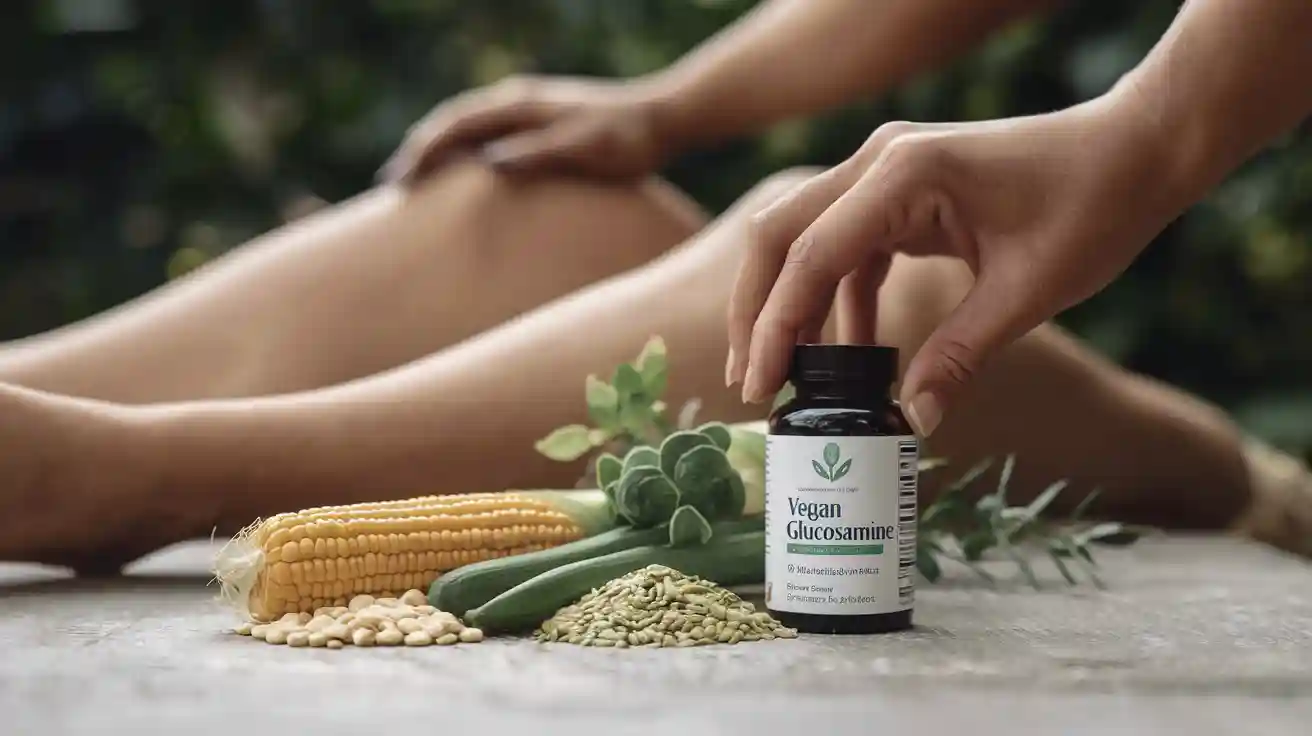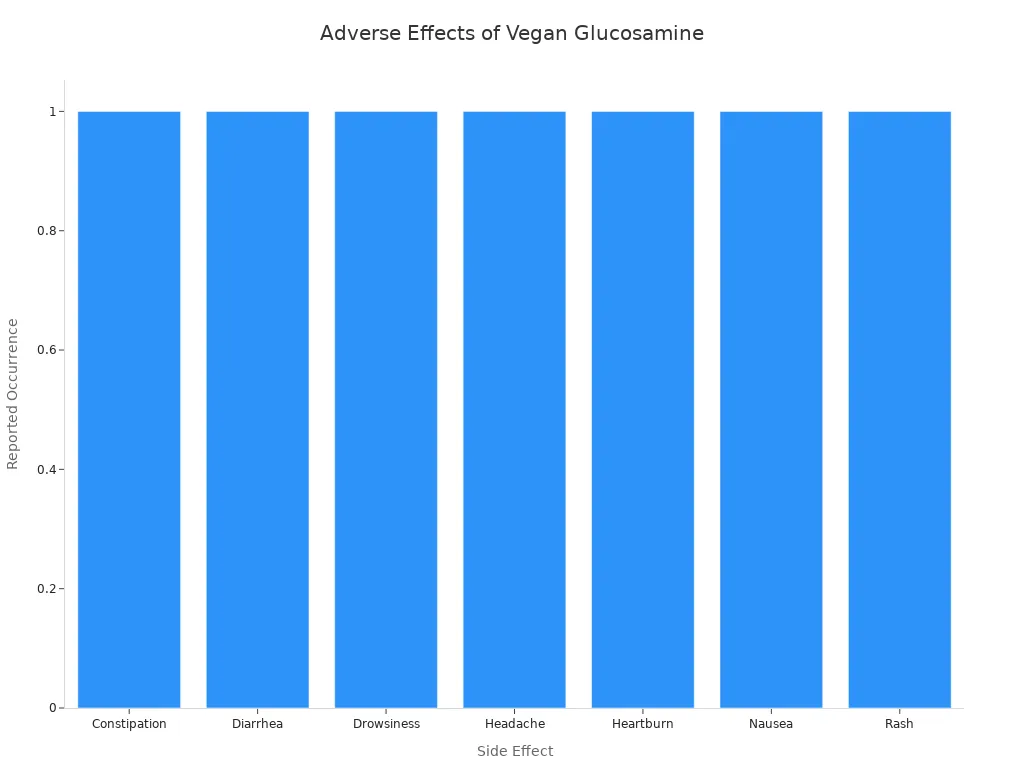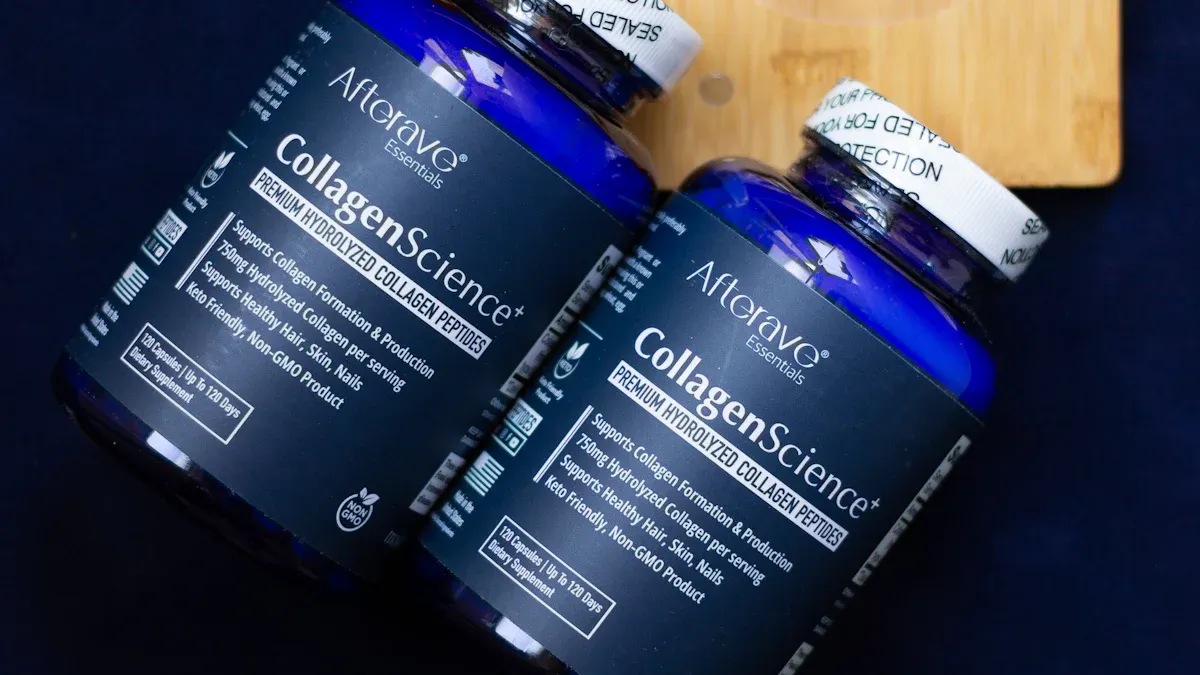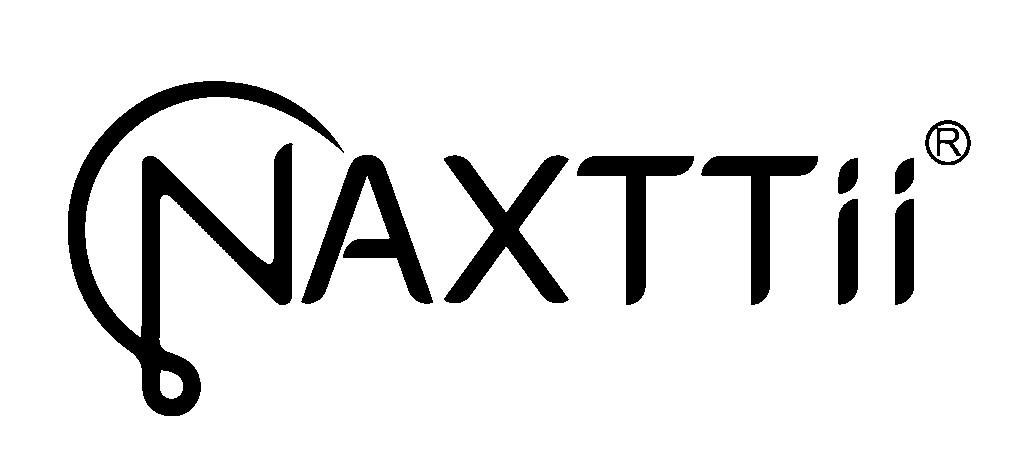Exploring Vegan Glucosamine for Osteoarthritis Relief
Table of Contents

You may wonder if vegan glucosamine can support your joint health when you have osteoarthritis. Current research shows that traditional glucosamine helps manage symptoms, but vegan glucosamine does not have enough clinical evidence or safety data yet. People with shellfish allergies or strict dietary needs often choose vegan glucosamine. You should use caution and speak with your doctor before adding it to your routine.
Vegan Glucosamine and Osteoarthritis
Evidence
You may want to know if vegan glucosamine can help with osteoarthritis. Researchers have studied glucosamine for many years. Most studies focus on traditional glucosamine, but some new research looks at plant-based options. One clinical trial in 2021 tested a plant-based glucosamine called Nucart VG, which combined vegan glucosamine with Boswellia Serrata. The study found that this combination helped people with mild to moderate knee osteoarthritis feel better. Here is a summary of that study:
| Study Title | Year | Findings |
|---|---|---|
| Effect of Nucart VG (Boswellia serrata in combination with veg glucosamine sulphate) in comparison with glucosamine sulphate to improve quality of life of knee osteoarthritis patients | 2021 | Plant-based glucosamine, combined with Boswellia Serrata, shows benefits for mild to moderate knee osteoarthritis treatment. |
When you look at larger reviews of glucosamine, the results are mixed. Some meta-analyses show that glucosamine and chondroitin do not always reduce pain, improve function, or lessen stiffness more than a placebo. Chondroitin may help with pain and function. Glucosamine seems to help most with stiffness. Both supplements are safe for most people and do not cause more side effects than a placebo.
- Glucosamine and chondroitin do not show significant effects on pain, function, and stiffness compared to placebo.
- Chondroitin may alleviate pain symptoms and improve function.
- Glucosamine shows a significant effect only on stiffness improvement.
- The combination of glucosamine and chondroitin does not demonstrate superiority over placebo.
- Both compounds are well tolerated with no significant difference in adverse events compared to placebo.
You should remember that most studies use traditional glucosamine from shellfish. Only a few studies test vegan glucosamine directly. More research is needed to know if vegan glucosamine works the same way.
How It Works
Glucosamine plays a key role in your body. It acts as a building block for cartilage, which covers the ends of your bones. Healthy cartilage cushions your joints and helps them move smoothly. When you have osteoarthritis, this cartilage breaks down. Glucosamine helps protect and strengthen cartilage. It also helps your joints keep their cushioning and stay lubricated.
- Glucosamine acts as a building block of cartilage, helping to protect and strengthen it.
- It aids in retaining the cushioning effects of cartilage and lubricating the joints.
- The compound plays a role in preventing further joint damage and reducing inflammation.
- Glucosamine enhances cartilage synthesis and inhibits cartilage breakdown.
You also need glucosamine for the normal growth and repair of connective tissues, especially in your joints. It is a major part of the extracellular matrix in cartilage. This matrix gives cartilage its strength and flexibility. Glucosamine helps your body make proteoglycans, which are important for healthy cartilage. Studies show that glucosamine can help your cells, called chondrocytes, make more cartilage and stop inflammation.
| Evidence Description | Details |
|---|---|
| Role in Cartilage Health | Glucosamine is essential for the normal growth and repair of connective tissues, particularly articular cartilage in synovial joints. |
| Contribution to ECM | It is a major component of the extracellular matrix of cartilage and a building block for proteoglycan synthesis. |
| Effects on Chondrocytes | Studies show that glucosamine stimulates the synthesis of cartilage matrix components and inhibits pro-inflammatory factors. |
If you want to support your joint health, you may consider glucosamine for osteoarthritis. Vegan glucosamine offers a plant-based option for people who avoid shellfish or animal products. While research on vegan glucosamine is still growing, its role in cartilage and connective tissue makes it a promising choice for many.
What Is Vegan Glucosamine?

Vegan glucosamine gives you a plant-based way to support your joints. You do not need to rely on animal products or worry about shellfish allergies. This type of glucosamine comes from plants and fungi, not from the shells of shrimp or crabs.
Sources
You can find vegan glucosamine made from several sources. Most companies use non-GMO corn or fungi. They use special fermentation processes to turn these raw materials into glucosamine. Some popular brands, like GlucosaGreen and GreenGrown, use non-GMO corn and keep their process clean and environmentally friendly. Fungi such as Aspergillus niger also provide a rich source of chitin, which helps make vegan glucosamine.
- Vegan glucosamine is made from non-GMO corn using fermentation.
- Some products use fungi, like Aspergillus niger, as the main source.
- Brands such as GlucosaGreen and GreenGrown focus on clean, non-GMO production.
You might wonder how companies turn plants or fungi into glucosamine. The process starts with raw materials that have a lot of polysaccharides. Workers wash and crush these materials to remove impurities. Next, they use enzymes like chitinase to break down the plant or fungal matter. After filtering and purifying the liquid, they dry it to get pure vegan glucosamine. This careful process ensures you get a high-quality supplement.
Differences
You may ask how vegan glucosamine compares to traditional glucosamine. The main difference comes from the source. Vegan glucosamine uses glucose from non-GMO corn or fungi. Traditional glucosamine comes from chitin in shellfish shells. To make shellfish glucosamine, companies use chemicals to break down the shells. Vegan glucosamine uses fermentation instead.
| Type | Source | Production Method |
|---|---|---|
| Vegan Glucosamine | Non-GMO corn, fungi | Fermentation, enzymes |
| Shellfish Glucosamine | Shellfish shells | Chemical extraction |
You may also notice a difference in absorption. Some studies suggest that the HCl form of glucosamine, which you can find in both vegan and traditional types, absorbs better in your small intestine. However, there is not enough data yet to say if vegan glucosamine works as well as the shellfish kind. Scientists agree that glucosamine helps manage osteoarthritis, but they want more research on vegan options.
Tip: If you have a shellfish allergy or follow a vegan diet, vegan glucosamine gives you a safe and effective alternative.
Glucosamine vs. Traditional Sources
Effectiveness
You may wonder if vegan glucosamine works as well as traditional glucosamine for osteoarthritis. Both types aim to help you manage joint pain and stiffness. Vegan glucosamine shows promise in improving osteoarthritis symptoms. Researchers say more studies are needed to compare vegan glucosamine with shellfish-derived glucosamine. A recent review highlights that plant-based glucosamine is sustainable and less likely to cause allergies. Most current studies focus on traditional glucosamine, so you should watch for new research on vegan options.
- Vegan glucosamine may help with osteoarthritis, but more research is needed.
- Plant-based glucosamine comes from corn fermentation and is considered sustainable.
- Studies comparing vegan and shellfish glucosamine are still limited.
Safety
You want to know if glucosamine supplementation is safe for long-term use. Studies show that both glucosamine and chondroitin sulfate reduce joint pain and improve mobility. Researchers collected data using doses for knee osteoarthritis. The observed safe level for glucosamine is up to 2000 mg per day. Chondroitin sulfate is safe up to 1200 mg per day. No adverse effects were reported at these levels. This supports the safety of glucosamine supplementation over time.
- Glucosamine supplementation at recommended doses is safe for most people.
- No serious side effects were found in long-term studies.
- Both vegan and traditional glucosamine are well tolerated.
You may experience mild side effects with vegan glucosamine. Here is a table showing possible reactions:
| Side Effect | Description |
|---|---|
| Constipation | Difficulty in bowel movements |
| Diarrhea | Loose or watery stools |
| Drowsiness | Feeling sleepy or lethargic |
| Headache | Pain in the head region |
| Heartburn | Burning sensation in the chest |
| Nausea | Feeling of sickness or urge to vomit |
| Rash | Skin irritation or allergic reaction |

Allergies
You may worry about allergies when choosing glucosamine. Shellfish-derived glucosamine can cause allergic reactions in sensitive people. Even if you do not have a known shellfish allergy, you may still react. Shellfish allergies affect about 2% of people worldwide. In the United States, shellfish is one of the top eight food allergens. Many people react to more than one type of shellfish, which increases the risk.
- Glucosamine chondroitin from shellfish can trigger allergies.
- Plant-based glucosamine sulfate is better for those with shellfish allergies.
- Vegan glucosamine comes from non-GMO corn, so there is no risk of shellfish contamination.
- Vegan glucosamine supplementation is safer for people with multiple food allergies.
- You have a lower risk of side effects with vegan glucosamine because it does not contain shellfish allergens.
Tip: If you have allergies or follow a vegan diet, vegan glucosamine gives you a safe choice for joint support.
Benefits of Vegan Glucosamine

For Vegans
You may want a supplement that fits your lifestyle and values. Vegan glucosamine gives you a way to support your joints without using animal products. This type of glucosamine comes from non-GMO corn or fungi, so you avoid shellfish and animal ingredients. You can trust that vegan glucosamine is kosher and vegan friendly. Many people choose it because it helps manage joint pain and supports cartilage function. Your body uses glucosamine to make glycosaminoglycans, which keep your joints flexible and healthy. If you have osteoarthritis or stiff joints, you may notice better mobility when you use glucosamine.
Benefits for Vegans:
- No risk of shellfish allergy reactions
- Kosher and vegan friendly
- No impurity risks from shellfish
- Supports joint health and cartilage function
Sustainability
You may care about the environment and want to make choices that protect nature. Vegan glucosamine uses sustainable production methods. Manufacturers use glucose from non-GMO corn and a fermentation process that saves water and reduces waste. The process uses 99.9% less water than traditional shellfish methods. It also creates 98% less landfill waste. You help protect marine life and ecosystems because vegan glucosamine does not use toxic chemicals. GlucosaGreen, a popular brand, shows that you can get high-quality glucosamine with minimal environmental impact.
Choosing vegan glucosamine helps you support your joints and the planet at the same time.
| Production Method | Water Usage | Landfill Waste | Chemical Byproducts |
|---|---|---|---|
| Vegan Glucosamine | Very Low | Very Low | None |
| Shellfish Glucosamine | High | High | Possible |
Allergy-Friendly
You may worry about allergies when picking a supplement. Traditional glucosamine comes from shellfish, which can cause allergic reactions. Vegan glucosamine uses corn fermentation, so you avoid the risk of shellfish allergies. This makes it a safer choice for people with food sensitivities. You can take vegan glucosamine with confidence, knowing it does not contain common allergens found in animal-based products.
If you have allergies or follow a vegan diet, vegan glucosamine gives you peace of mind and reliable joint support.
Limitations
Research Gaps
You may notice that scientists still have many questions about vegan glucosamine. Most studies focus on traditional glucosamine from shellfish. Researchers need more data on how vegan glucosamine affects joint pain and cartilage health. N-acetyl glucosamine, a form found in some vegan supplements, has not been studied enough for osteoarthritis relief. You may see claims about benefits for gut health, but strong clinical trials are missing. If you want to use glucosamine supplementation for joint support or gut health, you should know that experts call for more research. You may find that results vary between people, and doctors do not always agree on the best dose or form.
Note: Always check with your healthcare provider before starting glucosamine supplementation, especially if you want to improve joint or gut health.
Quality
You want to choose a high-quality vegan glucosamine supplement. Not all brands offer the same purity or effectiveness. Some companies use clear labeling to show that their glucosamine comes from fermented corn. You should look for glucosamine sulfate, which scientists study most often. The best supplements list all active compounds and show exact dosages. Many trials use 1500 mg per day, but the minimum effective dose is not clear yet. You may see products that combine glucosamine with Boswellia Serrata, MSM, curcumin, or magnesium for better joint and gut health. Third-party testing helps you trust the purity and potency of your supplement. Avoid products with synthetic fillers or unknown additives.
| Criteria | Description |
|---|---|
| Source transparency | Look for clear labeling that shows glucosamine is derived from fermented corn. |
| Clinically-supported form | Opt for glucosamine sulfate, which is the most studied form of glucosamine. |
| Transparent dosages | Choose supplements that disclose all active compounds and show exact dosages. |
| Optimal dosages | Many trials use 1500 mg per day, but the minimum effective amount is not well-established. |
| Synergistic ingredients | Look for joint-supporting compounds like Boswellia Serrata, MSM, curcumin, and magnesium. |
| Third-party testing | Pick supplements that are third-party tested for purity and potency. |
| Avoid synthetic fillers | Stay away from products with harmful additives. |
Side Effects
You may wonder about side effects from vegan glucosamine. Most people tolerate glucosamine supplementation well, but some experience mild problems. You might notice indigestion, constipation, diarrhea, headaches, or rashes. Some people report bloating and nausea. These side effects usually do not last long. If you have gut health concerns, you should watch for digestive changes when you start glucosamine. Always read the label and start with a low dose to see how your body reacts.
| Side Effect | Description |
|---|---|
| Indigestion | Mild digestive discomfort. |
| Constipation | Difficulty in bowel movements. |
| Diarrhea | Loose or watery stools. |
| Headaches | Mild to moderate pain in the head. |
| Rashes | Skin reactions that may occur. |
- Bloating
- Nausea
- Diarrhea
- Constipation
Tip: If you notice any side effects, stop glucosamine supplementation and talk to your doctor. You may need to try a different dose or brand.
Choosing Vegan Glucosamine
Dosage
You want to know how much glucosamine to take for osteoarthritis. Most clinical trials recommend a daily oral dose of 1,500 mg of glucosamine sulfate. This amount supports your joint health and may help reduce pain. You can split the dose into smaller amounts throughout the day or take it all at once. Always check the label on your supplement for the exact amount of glucosamine per serving.
- The common daily oral dosage of glucosamine sulfate for osteoarthritis is 1,500 mg.
- You can take glucosamine in one dose or divide it into two or three smaller doses.
- Many supplements use glucosamine sulfate, which is the most studied form.
Tip: Start with the recommended dose and watch for any side effects. If you feel discomfort, talk to your doctor before changing your routine.
Who Should Use It
You may wonder if vegan glucosamine is right for you. This supplement helps many people who want to support joint function and manage osteoarthritis symptoms. You might benefit from vegan glucosamine if you have knee pain or stiffness. People with shellfish allergies choose vegan glucosamine because it does not contain animal products. You may also prefer vegan glucosamine for ethical or environmental reasons.
- Individuals with osteoarthritis, especially in weight-bearing joints like the knees.
- People with shellfish allergies who need a safe glucosamine alternative.
- Those seeking plant-based options for ethical or environmental reasons.
Vegan glucosamine is well tolerated. Most people do not experience serious side effects. Some may notice mild symptoms like nausea, headache, bloating, or changes in bowel movements. These effects usually go away quickly. There are no known contraindications for specific groups, so you can use vegan glucosamine with confidence.
| Who Should Use Vegan Glucosamine | Reason for Use |
|---|---|
| People with osteoarthritis | Support joint function and reduce pain |
| Those with shellfish allergies | Avoid animal-derived ingredients |
| Vegans and vegetarians | Choose plant-based supplements |
| Eco-conscious individuals | Prefer sustainable production |
Note: Always consult your healthcare provider before starting any new supplement, especially if you have health concerns.
You now know that vegan glucosamine offers a plant-based way to support your joints. Studies show glucosamine can reduce pain, improve knee stiffness, and help you move better. See the table below for a quick summary:
| Pain Scores | Knee Stiffness | Physical Function | Safety |
|---|---|---|---|
| Reduced | Improved | Enhanced | Well tolerated |
If you want to try glucosamine, follow these tips:
- Switch slowly if you used shellfish-based glucosamine before.
- Pick products with few fillers.
- Choose blends with turmeric, MSM, or magnesium.
- Store your supplement in a cool, dry place.
- Talk to your healthcare provider first.
FAQ
Can you take vegan glucosamine if you have a shellfish allergy?
Yes, you can. Vegan glucosamine does not contain shellfish or animal products. It comes from corn or fungi. You avoid the risk of allergic reactions linked to shellfish-based supplements.
How long does it take to feel results from vegan glucosamine?
You may notice changes in joint comfort after 4 to 8 weeks. Some people feel relief sooner. Results can vary. You should take the supplement daily for the best effect.
Is vegan glucosamine safe for long-term use?
Most people use vegan glucosamine safely for months or years. Side effects are rare and mild. You should talk to your doctor before starting any new supplement, especially if you have health concerns.
Can children or teens use vegan glucosamine?
Doctors do not recommend glucosamine for children or teens unless advised. Most studies focus on adults with joint pain. Always ask your healthcare provider before giving supplements to young people.

Poseidon
Master of Nutritional Epidemiology, University of Copenhagen, Herbal Functional Nutrition Researcher
Focus: The scientific application of natural active ingredients such as Tongo Ali, Horny Goat Weed, and Maca to sexual health and metabolic regulation.
Core Focus:
Men: Use a combination of Tongo Ali (an energizing factor) + Maca (an energy reserve) to improve low energy and fluctuating libido.
Women: Use a combination of Horny Goat Weed (a gentle regulator) + Maca (a nutritional synergist) to alleviate low libido and hormonal imbalances.
Stressed/Middle-Aged Adults: This triple-ingredient synergy supports metabolism, physical strength, and intimacy.
Product Concept:
Based on traditional applications and modern research (e.g., Tongo Ali promotes testosterone-enhancing enzyme activity, and icariin provides gentle regulation), we preserve core active ingredients and eschew conceptual packaging—using natural ingredients to address specific needs.
Simply put: I'm a nutritionist who understands "herbal actives." I use scientifically proven ingredients like Tongo Ali, Epimedium, and Maca to help you make "sexual health" and "nutritional support" a daily routine.
